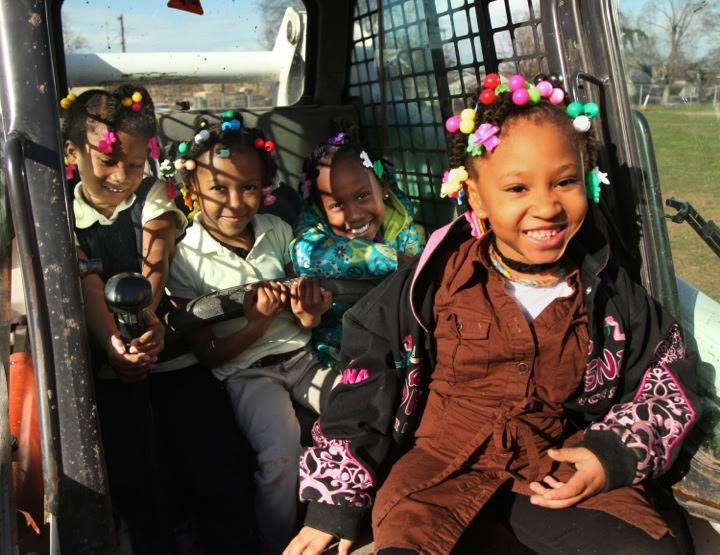AWESOME PROJECT: Help fund a sweet new climbing tree playground for a Louisville grade school
Published February 24, 2016
When’s the last time you climbed a tree? Was it back in grade school? Do you remember the feeling of being high up and protected by a nest of branches, all alone with the breeze in your hair? Cindi Sullivan remembers.
“I’m a tree climber from way back,” she explains. “I was fortunate enough to grow up on a farm for a while where I could hop on my bike and go climb a tree anytime. I actually lived on a University of Kentucky fruit and vegetable research farm during my adolescent years, so I would climb fruit trees and sit there and eat an apple, or eat a peach. I was a scrawny little kid, and not very athletically inclined, so I was never very good at sports, but I could climb a tree and see how far I could get. It really was a place to be able to get out and be alone. That’s a big part of it. That sense of space. Most of the time no one knew where I was.”

Today, as Executive Director of nonprofit Trees Louisville, Sullivan is on a mission to bring that sense of space and freedom to at-risk kids in urban schools. Her organization isn’t even a year old – it was founded in Fall 2015 – but the team has already worked with 13 schools to bring big, majestic trees to prison-like playgrounds and barren, neglected open spaces.
“Many of them really don’t have the opportunities to be alone,” Sullivan says of the kids her organization serves. “These are areas where you talk about Nature Deficit Syndrome. They go from being in an apartment to getting in a car, to going to school, back in the car or bus, and back into the apartment. A lot of kids just don’t get out and play like they used to.”

A Waldorf-inspired school gets a big, big gift
Right now, Trees Louisville is raising money via ioby to continue a tree planting project at one of those 13 schools: Maupin Elementary. An innovative, Waldorf-inspired school, Maupin staff believe in teaching through play, nature, arts, and dance, as well as more traditional curriculum. So it’s fitting that they’re to be the recipients, if enough money is raised (and they’re more than halfway to their goal of $28,871), of an absolutely majestic, almost-fairytale-proportioned 35-year old Contorted European Beech tree. In plain English, that’s world’s best climbing tree ever. The thing is 25 feet wide, and 15 feet tall. WHOA.
So, why climb trees? Well, from muscular development to cognitive fine-tuning, to problem solving and a source of deep pride and autonomy, tree-climbing is one of the best educational and development tools around. And $28,000 may sound steep, but compare that to the tens of thousands that the school could otherwise spend on plastic climbing sets.
“Comparable plastic play equipment that you climb up and slide down,” says Sullivan, “that’s tens of thousands of dollars. Those things are upwards of 30, 40, 50 thousand dollars, depending on how many components you put together. This is a real living organism that will provide so much more than plastic play equipment could.”

That’s great for little climbers, but what does the town get?
Maupin’s tiny climbers are hardly the only ones who’ll benefit from the 60 trees already planted at the school – “they just were fascinated,” says Sullivan, “and you could tell that this was their first experience of how trees get planted” – and from the huge European Beech on the way.
“We’re helping the community at large,” explains Sullivan, “because every time we plant a tree, we’re improving the overall canopy. Which means we’re fighting the urban heat island effect, we’re managing storm water, we’re improving air quality, we’re saving energy, we’re reducing emissions. All those ecosystem services that a good healthy robust canopy will provide to a community.”
That’s a big deal, actually, because tree canopies nationwide have been taking a real hit these last couple of decades. “Budgets are tight,” says Sullivan. “You can only do so much. One of the things that unfortunately gets put on the chopping block is landscaping and maintenance and tending to trees. For the last several decades, we haven’t done a good job of keeping up and improving our canopy, and that’s why so many cities have canopy deficits and problems.”
To donate, or to learn more, visit Trees Louisville’s campaign page here. Your donation will help to pay for the massive, million-dollar equipment needed to transport the climbing tree to Maupin. By the way, the kids don’t know about it, yet. They’re thrilled with the 60 modest new trees they’ve already received – they didn’t want to go back inside on recess days when they were being planted – and have no idea that the best is yet to come. What a surprise, huh?
Feeling inspired? Want to take action in YOUR neighborhood? If you have awesome ideas about how to make your town greener, safer, and more fun, let us help! Tell us your awesome idea right here. We’d love to help you get started today.
Pssst…. In OTHER ioby news: Want to learn more about how people just like you are greening America’s cities through civic stewardship, crowd resourcing, and social networking? Check out this awesome guest post by our all-star board member, Lindsay Campbell. She’s a Research Social Scientist for the USDA Forest Service, and kicks butt on the competitive international fencing scene in her spare time.
